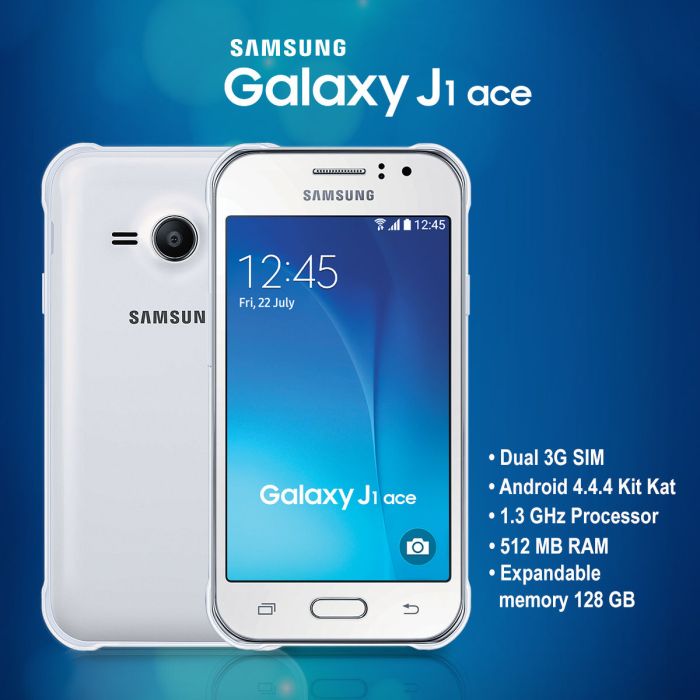Samsung Galaxy J1 Duos Specification Overview
Samsung Galaxy J1 Duos: A Budget Smartphone Retrospective
Samsung galaxy j1 duos specification – The Samsung Galaxy J1 Duos, launched in 2015, represented Samsung’s foray into the burgeoning budget smartphone market. This device aimed to provide essential smartphone functionality at an affordable price point, targeting a specific segment of consumers.
Introduction to Samsung Galaxy J1 Duos
The Galaxy J1 Duos was positioned as an entry-level smartphone, focusing on providing basic functionality at a competitive price. Its target audience included first-time smartphone users, budget-conscious consumers, and individuals seeking a reliable secondary device. The phone’s lifecycle spanned several years, with software updates and carrier variations extending its availability across various markets.
Key Specifications and Features
The Galaxy J1 Duos featured modest specifications typical of its budget segment. A comparison against a contemporary competitor highlights its capabilities and limitations.
| Feature | Galaxy J1 Duos | Competitor Phone (Example: Motorola Moto E (2015)) | Comparison Note |
|---|---|---|---|
| Processor | Spreadtrum SC7731 | Qualcomm Snapdragon 410 | The Snapdragon 410 offered slightly better performance. |
| RAM | 512 MB | 1 GB | The Moto E had double the RAM, leading to smoother multitasking. |
| Storage | 4 GB (expandable) | 8 GB (expandable) | Both offered expandable storage, but the Moto E provided more internal space. |
| Camera (Rear) | 5 MP | 5 MP | Similar megapixel count, but image quality varied depending on sensor and processing. |
Core hardware specifications included a Spreadtrum SC7731 processor, 512 MB of RAM, and 4 GB of internal storage, expandable via microSD card. The device featured a 5-megapixel rear camera and a 2-megapixel front camera.
Software features at launch included the standard Android operating system (version likely 4.4 or 5.0, depending on the market and release date), alongside Samsung’s TouchWiz user interface. Other features may have included basic connectivity options (Wi-Fi, Bluetooth, etc.).
- TouchWiz UI
- Basic Connectivity (Wi-Fi, Bluetooth)
- Dual SIM Capability
Performance and User Experience

Source: naptol.com
Given its specifications, the Galaxy J1 Duos offered acceptable performance for basic tasks such as calling, texting, and using light applications. However, multitasking and running more demanding apps could lead to noticeable lag. The TouchWiz interface, while visually appealing, could sometimes feel sluggish on the limited hardware.
Battery life was generally considered adequate for a day of moderate use, though heavy use could necessitate more frequent charging. The exact battery life varied depending on usage patterns.
Strengths and Weaknesses
The Galaxy J1 Duos, like any device, had its strengths and weaknesses. A comparison with similar budget phones reveals its competitive advantages and disadvantages.
- Strengths: Affordable price, dual SIM functionality (useful in many markets), and relatively compact design.
- Weaknesses: Limited processing power, low RAM resulting in performance bottlenecks, and a camera that produced average image quality, particularly in low light.
Compared to competitors, the J1 Duos often fell behind in raw processing power and RAM but offered a competitive price point. Its dual-SIM capability was a key differentiator in certain regions.
Legacy and Impact
The Galaxy J1 Duos contributed to Samsung’s market share in the budget smartphone sector, demonstrating the company’s commitment to offering devices across a range of price points. While it didn’t revolutionize the market, it solidified Samsung’s presence in the entry-level segment. Its impact on subsequent Samsung models is less directly traceable, as the company’s product lines evolve rapidly. User reception was generally mixed, with many appreciating its affordability while acknowledging its performance limitations.
Technical Specifications Table (Alternative Presentation), Samsung galaxy j1 duos specification
| Specification | Value | Unit | Notes |
|---|---|---|---|
| Processor | Spreadtrum SC7731 | – | Dual-core processor |
| RAM | 512 | MB | Limited RAM capacity |
| Storage | 4 | GB | Expandable via microSD |
| Display | 4.3 | inches | Super AMOLED display |
| Camera (Rear) | 5 | MP | Basic image quality |
| Camera (Front) | 2 | MP | Basic video calling |
| Battery | 1850 | mAh | Moderate battery life |
| Operating System | Android | – | Version varied by region and release date |
Illustrative Example: Camera Performance

Source: androidweblog.com
A photograph taken with the Galaxy J1 Duos’s 5MP rear camera in bright sunlight would show reasonably sharp details in the central portion of the image. However, the image quality would degrade towards the edges, with some noticeable softness and loss of detail. Colors might appear slightly washed out, and dynamic range would be limited, with highlights clipping easily in brightly lit areas and shadows appearing dark and lacking detail.
In low-light conditions, image noise would become significantly more apparent, with a loss of sharpness and a general graininess to the image. Colors would be less accurate, and detail would be significantly reduced.
FAQ Compilation: Samsung Galaxy J1 Duos Specification
Is the Samsung Galaxy J1 Duos still receiving software updates?
No, the Samsung Galaxy J1 Duos is no longer receiving official software updates from Samsung.
What is the typical storage capacity available for apps and media on the J1 Duos?
The internal storage varied depending on the model, but generally offered limited space. Users often needed to rely on microSD cards for expanded storage.
How does the J1 Duos compare to other budget phones released around the same time?
Compared to competitors, the J1 Duos offered a comparable level of basic functionality at a similar price point. However, its performance and camera quality might have lagged behind some of its rivals.





















